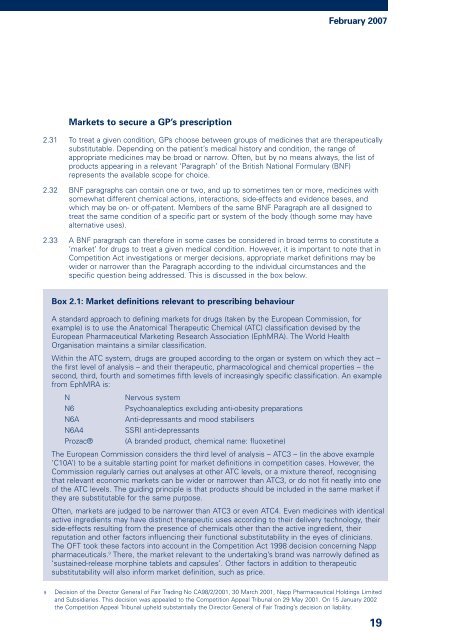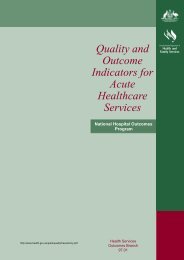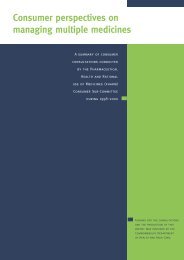The Pharmaceutical Price Regulation Scheme - Office of Fair Trading
The Pharmaceutical Price Regulation Scheme - Office of Fair Trading
The Pharmaceutical Price Regulation Scheme - Office of Fair Trading
You also want an ePaper? Increase the reach of your titles
YUMPU automatically turns print PDFs into web optimized ePapers that Google loves.
February 2007<br />
Markets to secure a GP’s prescription<br />
2.31 To treat a given condition, GPs choose between groups <strong>of</strong> medicines that are therapeutically<br />
substitutable. Depending on the patient’s medical history and condition, the range <strong>of</strong><br />
appropriate medicines may be broad or narrow. Often, but by no means always, the list <strong>of</strong><br />
products appearing in a relevant ‘Paragraph’ <strong>of</strong> the British National Formulary (BNF)<br />
represents the available scope for choice.<br />
2.32 BNF paragraphs can contain one or two, and up to sometimes ten or more, medicines with<br />
somewhat different chemical actions, interactions, side-effects and evidence bases, and<br />
which may be on- or <strong>of</strong>f-patent. Members <strong>of</strong> the same BNF Paragraph are all designed to<br />
treat the same condition <strong>of</strong> a specific part or system <strong>of</strong> the body (though some may have<br />
alternative uses).<br />
2.33 A BNF paragraph can therefore in some cases be considered in broad terms to constitute a<br />
‘market’ for drugs to treat a given medical condition. However, it is important to note that in<br />
Competition Act investigations or merger decisions, appropriate market definitions may be<br />
wider or narrower than the Paragraph according to the individual circumstances and the<br />
specific question being addressed. This is discussed in the box below.<br />
Box 2.1: Market definitions relevant to prescribing behaviour<br />
A standard approach to defining markets for drugs (taken by the European Commission, for<br />
example) is to use the Anatomical <strong>The</strong>rapeutic Chemical (ATC) classification devised by the<br />
European <strong>Pharmaceutical</strong> Marketing Research Association (EphMRA). <strong>The</strong> World Health<br />
Organisation maintains a similar classification.<br />
Within the ATC system, drugs are grouped according to the organ or system on which they act –<br />
the first level <strong>of</strong> analysis – and their therapeutic, pharmacological and chemical properties – the<br />
second, third, fourth and sometimes fifth levels <strong>of</strong> increasingly specific classification. An example<br />
from EphMRA is:<br />
N<br />
N6<br />
N6A<br />
N6A4<br />
Prozac®<br />
Nervous system<br />
Psychoanaleptics excluding anti-obesity preparations<br />
Anti-depressants and mood stabilisers<br />
SSRI anti-depressants<br />
(A branded product, chemical name: fluoxetine)<br />
<strong>The</strong> European Commission considers the third level <strong>of</strong> analysis – ATC3 – (in the above example<br />
‘C10A’) to be a suitable starting point for market definitions in competition cases. However, the<br />
Commission regularly carries out analyses at other ATC levels, or a mixture there<strong>of</strong>, recognising<br />
that relevant economic markets can be wider or narrower than ATC3, or do not fit neatly into one<br />
<strong>of</strong> the ATC levels. <strong>The</strong> guiding principle is that products should be included in the same market if<br />
they are substitutable for the same purpose.<br />
Often, markets are judged to be narrower than ATC3 or even ATC4. Even medicines with identical<br />
active ingredients may have distinct therapeutic uses according to their delivery technology, their<br />
side-effects resulting from the presence <strong>of</strong> chemicals other than the active ingredient, their<br />
reputation and other factors influencing their functional substitutability in the eyes <strong>of</strong> clinicians.<br />
<strong>The</strong> OFT took these factors into account in the Competition Act 1998 decision concerning Napp<br />
pharmaceuticals. 9 <strong>The</strong>re, the market relevant to the undertaking’s brand was narrowly defined as<br />
‘sustained-release morphine tablets and capsules’. Other factors in addition to therapeutic<br />
substitutability will also inform market definition, such as price.<br />
9 Decision <strong>of</strong> the Director General <strong>of</strong> <strong>Fair</strong> <strong>Trading</strong> No CA98/2/2001, 30 March 2001, Napp <strong>Pharmaceutical</strong> Holdings Limited<br />
and Subsidiaries. This decision was appealed to the Competition Appeal Tribunal on 29 May 2001. On 15 January 2002<br />
the Competition Appeal Tribunal upheld substantially the Director General <strong>of</strong> <strong>Fair</strong> <strong>Trading</strong>’s decision on liability.<br />
19




